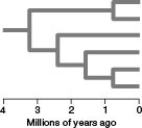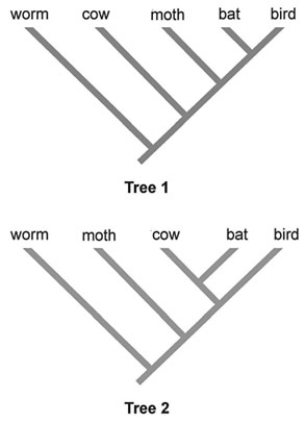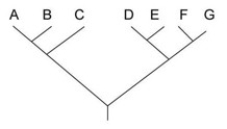A) lizards and elephants
B) pterosaurs, dinosaurs, and birds
C) synapsids, monotremes, marsupials, rodents, and primates
D) lizards, pterosaurs, dinosaurs, birds, synapsids, monotremes, marsupials, rodents, and primates
E) elephants only
G) B) and E)
Correct Answer

verified
Correct Answer
verified
Multiple Choice
All of the following events can trigger an adaptive radiation EXCEPT ________.
A) an unusual event splitting a habitat, such as a severe hurricane
B) the evolution of a new morphological feature
C) the colonization of a new habitat
D) the extinction of competitors
E) Hox gene duplication events
G) C) and E)
Correct Answer

verified
Correct Answer
verified
Multiple Choice
Which of the following is the best explanation for the high degree of sequence homology observed in Exon I among these five species?
A) It is the most upstream exon of this gene.
B) Due to alternative gene splicing, this exon is often treated as an intron.
C) It codes for a polypeptide domain that has a crucial function.
D) These five species must actually constitute a single species.
E) This exon is rich in G-C base pairs; thus, it is more stable.
G) A) and C)
Correct Answer

verified
Correct Answer
verified
Multiple Choice
Which of the following is an example of homoplasy?
A) fur in bears and seals
B) cell walls in plants and fungi
C) chlorophyll in flowering plants and algae
D) scales in snakes and lizards
F) B) and C)
Correct Answer

verified
Correct Answer
verified
Multiple Choice
Regarding these sequence homology data, the principle of maximum parsimony would be applicable in ________.
A) distinguishing introns from exons
B) determining degree of sequence homology
C) selecting appropriate genes for comparison among species
D) inferring evolutionary relatedness from the number of sequence differences
F) A) and D)
Correct Answer

verified
Correct Answer
verified
Multiple Choice
Which value(s) would be required to calculate how long ago the most recent ancestor of ungulates lived? I. the number of base pairs that differ among species in a certain genetic sequence II. the total number of base pairs in the genetic sequence examined III. the age of a fossil ancestor for calibration
A) I
B) II
C) III
D) I, II, and III
F) A) and C)
Correct Answer

verified
Correct Answer
verified
Multiple Choice
All things being equal, which of these is the most parsimonious explanation for the change in the number of Hox genes from the last common ancestor of insects and vertebrates to ancestral vertebrates, as shown in the table above?
A) The occurrence of seven independent duplications of individual Hox genes.
B) The occurrence of two distinct duplications of the entire seven-gene cluster, followed by the loss of one cluster.
C) The occurrence of a single duplication of the entire seven-gene cluster.
D) Two distinct duplications of a three-gene cluster of Hox genes, followed by an independent duplication of an individual Hox gene.
F) A) and B)
Correct Answer

verified
Correct Answer
verified
Multiple Choice
Two competing hypotheses to account for the increase in the number of Hox genes from the last common ancestor of bilaterians to the last common ancestor of insects and vertebrates are: (1) a single duplication of the entire four-gene cluster, followed by the loss of one gene, and (2) three independent duplications of individual Hox genes. To prefer the first hypothesis on the basis of parsimony requires the assumption that ________.
A) the duplication of a cluster of four Hox genes is equally likely to the duplication of a single Hox gene
B) there is an actual process by which individual genes can be duplicated
C) genes can exist in spatial groupings called clusters
D) clusters of genes can undergo disruption, with individual genes moving to different chromosomes during evolution
F) All of the above
Correct Answer

verified
Correct Answer
verified
Multiple Choice
Members of two different species possess a similar-looking structure that they use in a similar way to perform about the same function. Which of the following would suggest that the relationship more likely represents homology instead of convergent evolution?
A) The two species live at great distance from each other.
B) The two species share many proteins in common, and the nucleotide sequences that code for these proteins are almost identical.
C) The structures in adult members of both species are similar in size.
D) Both species are well adapted to their particular environments.
F) A) and C)
Correct Answer

verified
Correct Answer
verified
Multiple Choice
 Which of the following is TRUE of all horizontally oriented phylogenetic trees, where time advances to the right?
Which of the following is TRUE of all horizontally oriented phylogenetic trees, where time advances to the right?
A) Each branch point represents a point in absolute time.
B) Organisms represented at the base of such trees are descendants of those represented at higher levels.
C) The fewer branch points that occur between two taxa, the more divergent their DNA sequences should be.
D) The common ancestor represented by a branch point farther right existed more recently in time than the common ancestors represented at branch points located farther to the left.
E) The more branch points there are, the fewer taxa are likely to be represented.
G) A) and E)
Correct Answer

verified
Correct Answer
verified
Multiple Choice
Approximately how far back in time does the fossil record extend?
A) 3.5 million years
B) 5.0 million years
C) 3.5 billion years
D) 5.0 billion years
F) C) and D)
Correct Answer

verified
Correct Answer
verified
Multiple Choice
Some beetles and flies have antler-like structures on their heads, much like male deer do. The existence of antlers in beetle, fly, and deer species with strong male-male competition is an example of ________.
A) convergent evolution
B) a synapomorphy
C) homology
D) parsimony
F) A) and C)
Correct Answer

verified
Correct Answer
verified
Multiple Choice
 Considering the phylogenetic trees above as strictly hypothetical and applying the principle of parsimony to the trait "ability to fly," which of the two phylogenetic trees shown is better?
Considering the phylogenetic trees above as strictly hypothetical and applying the principle of parsimony to the trait "ability to fly," which of the two phylogenetic trees shown is better?
A) Tree 1
B) Tree 2
C) Both trees are equally parsimonious.
D) Since the trees show different evolutionary relationships, you cannot determine which is more parsimonious.
F) C) and D)
Correct Answer

verified
Correct Answer
verified
Multiple Choice
Use the following tree to answer the question below.  Which of the following trees, if any, depicts the same relationship among species as shown above?
Which of the following trees, if any, depicts the same relationship among species as shown above?
A) ![]()
B) ![]()
C) ![]()
D) None of the above.
F) None of the above
Correct Answer

verified
Correct Answer
verified
Multiple Choice
When using a cladistic approach to systematics, which of the following is considered most important for classification?
A) shared ancestral characters
B) homoplasic ancestral characters
C) shared derived characters
D) the number of homoplasies
E) overall phenotypic similarity
G) D) and E)
Correct Answer

verified
Correct Answer
verified
Multiple Choice
In plant communities today, leaf morphology is correlated with mean annual temperature, so paleobotanists use fossil leaf morphology to estimate the mean annual temperature of paleoclimates. However, the angiosperm fossil record contains an overabundance of samples fossilized near lakes or rivers where vines are especially common. Since vine leaves have a somewhat different association with temperature, use of data from vine-rich locations leads to mean average temperature estimates that are lower than actual recorded temperatures in modern plant communities. This potential bias in paleobotanical climate estimates is due to which type of bias in the fossil record? (R. J. Burnham, N. C. A. Pitman, K. R. Johnson, and P. Wilf. 2001. Habitat-related error in estimating temperature from leaf margins in a humid tropical forest. American Journal of Botany 88:1096-1102.)
A) taxonomic bias
B) temporal bias
C) habitat bias
D) abundance bias
F) B) and C)
Correct Answer

verified
Correct Answer
verified
Multiple Choice
If you were using cladistics to build a phylogenetic tree of cats, which of the following would be the best outgroup?
A) lion
B) domestic cat
C) wolf
D) leopard
E) tiger
G) A) and C)
Correct Answer

verified
Correct Answer
verified
Multiple Choice
Which of the following would be LEAST likely in the fossil record?
A) burrowing species
B) marine-dwelling species
C) marsh-dwelling species
D) desert-dwelling species
F) A) and C)
Correct Answer

verified
Correct Answer
verified
Multiple Choice
Which of these four gene parts should allow the construction of the most accurate phylogenetic tree, assuming that this is the only part of the gene that has acted as a reliable molecular clock?
A) Intron I
B) Exon I
C) Intron VI
D) Exon V
F) All of the above
Correct Answer

verified
Correct Answer
verified
Multiple Choice
Use the following table to answer the question(s) below.  -What conclusion is apparent from the data in the accompanying table?
-What conclusion is apparent from the data in the accompanying table?
A) Land animals have more Hox genes than do those that live in water.
B) All bilaterian phyla have had the same degree of expansion in their numbers of Hox genes.
C) Acoel flatworms should be expected to contain seven Hox genes.
D) The expansion in number of Hox genes throughout vertebrate evolution cannot be explained merely by three duplications of the ancestral vertebrate Hox cluster.
E) Extant insects all have seven Hox genes.
G) None of the above
Correct Answer

verified
Correct Answer
verified
Showing 21 - 40 of 63
Related Exams